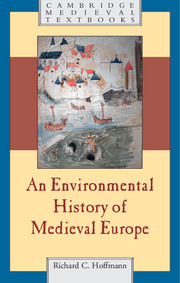Book contents
- Frontmatter
- Contents
- List of figures
- List of maps
- Preface
- Frontispiece: Nature and culture at Waterford, Ireland, 1372
- Introduction: Thinking about medieval Europeans in their natural world
- 1 Long no wilderness
- 2 Intersecting instabilities: culture and nature at medieval beginnings, c.400–900
- 3 Humankind and God’s Creation in medieval minds
- 4 Medieval land use and the formation of traditional European landscapes
- 5 Medieval use, management, and sustainability of local ecosystems, 1: primary biological production sectors
- 6 Medieval Use, management, and sustainability of local ecosystems, 2: interactions with the non-living environment
- 7 ‘This belongs to me . . .’
- 8 Suffering the uncomprehended: disease as a natural agent
- 9 An inconstant planet, seen and unseen, under foot and overhead
- 10 A slow end of medieval environmental relations
- Afterword
- A sampler for further reading
- Index
2 - Intersecting instabilities: culture and nature at medieval beginnings, c.400–900
Published online by Cambridge University Press: 05 July 2014
- Frontmatter
- Contents
- List of figures
- List of maps
- Preface
- Frontispiece: Nature and culture at Waterford, Ireland, 1372
- Introduction: Thinking about medieval Europeans in their natural world
- 1 Long no wilderness
- 2 Intersecting instabilities: culture and nature at medieval beginnings, c.400–900
- 3 Humankind and God’s Creation in medieval minds
- 4 Medieval land use and the formation of traditional European landscapes
- 5 Medieval use, management, and sustainability of local ecosystems, 1: primary biological production sectors
- 6 Medieval Use, management, and sustainability of local ecosystems, 2: interactions with the non-living environment
- 7 ‘This belongs to me . . .’
- 8 Suffering the uncomprehended: disease as a natural agent
- 9 An inconstant planet, seen and unseen, under foot and overhead
- 10 A slow end of medieval environmental relations
- Afterword
- A sampler for further reading
- Index
Summary
Europeans’ relations with their natural surroundings were recalibrated during a long, slow breakdown of one dominant culture, the classical Mediterranean, and piecemeal emergence of another, more distinctly European one. The half-millennium from around 400 to 900 ce can be labelled ‘late antiquity’ or called the ‘early Middle Ages’; the names of historical periods depend on where the observer stands and what she looks at. Grasping the processes of early medieval environmental change starts from the breakdown of Roman hegemony in the west. A synergy between cultural and natural variables so affected Mediterranean and northern Europe alike, that notably the archaeological and material evidence marks sharp breaks in relations between people and the land on both sides of the Alps. A simultaneous loss of literate interest in material life effaces historical view of how contemporaries understood this. Then just as some new patterns seem to emerge, historians become able to see more clearly, thanks to a cultural revival, the so-called ‘Carolingian renaissance’, that had little directly to do with environmental relations. The late eighth and ninth century reopened literate access to this world. Even with self-conscious reference to what some thought classical models, powerful and ordinary people were together organizing agroecosystems and landscapes unlike those of the now-vanished classical Mediterranean or its barbarian neighbours.
- Type
- Chapter
- Information
- An Environmental History of Medieval Europe , pp. 51 - 84Publisher: Cambridge University PressPrint publication year: 2014

